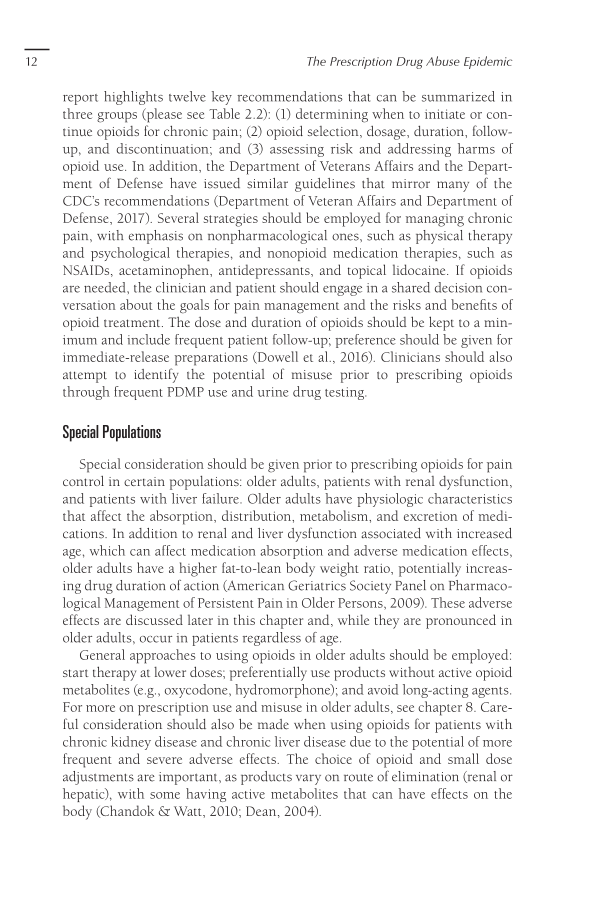12 The Prescription Drug Abuse Epidemic report highlights twelve key recommendations that can be summarized in three groups (please see Table 2.2): (1) determining when to initiate or con- tinue opioids for chronic pain (2) opioid selection, dosage, duration, follow- up, and discontinuation and (3) assessing risk and addressing harms of opioid use. In addition, the Department of Veterans Affairs and the Depart- ment of Defense have issued similar guidelines that mirror many of the CDC’s recommendations (Department of Veteran Affairs and Department of Defense, 2017). Several strategies should be employed for managing chronic pain, with emphasis on nonpharmacological ones, such as physical therapy and psychological therapies, and nonopioid medication therapies, such as NSAIDs, acetaminophen, antidepressants, and topical lidocaine. If opioids are needed, the clinician and patient should engage in a shared decision con- versation about the goals for pain management and the risks and benefits of opioid treatment. The dose and duration of opioids should be kept to a min- imum and include frequent patient follow-up preference should be given for immediate-release preparations (Dowell et al., 2016). Clinicians should also attempt to identify the potential of misuse prior to prescribing opioids through frequent PDMP use and urine drug testing. Special Populations Special consideration should be given prior to prescribing opioids for pain control in certain populations: older adults, patients with renal dysfunction, and patients with liver failure. Older adults have physiologic characteristics that affect the absorption, distribution, metabolism, and excretion of medi- cations. In addition to renal and liver dysfunction associated with increased age, which can affect medication absorption and adverse medication effects, older adults have a higher fat-to-lean body weight ratio, potentially increas- ing drug duration of action (American Geriatrics Society Panel on Pharmaco- logical Management of Persistent Pain in Older Persons, 2009). These adverse effects are discussed later in this chapter and, while they are pronounced in older adults, occur in patients regardless of age. General approaches to using opioids in older adults should be employed: start therapy at lower doses preferentially use products without active opioid metabolites (e.g., oxycodone, hydromorphone) and avoid long-acting agents. For more on prescription use and misuse in older adults, see chapter 8. Care- ful consideration should also be made when using opioids for patients with chronic kidney disease and chronic liver disease due to the potential of more frequent and severe adverse effects. The choice of opioid and small dose adjustments are important, as products vary on route of elimination (renal or hepatic), with some having active metabolites that can have effects on the body (Chandok & Watt, 2010 Dean, 2004).
Document Details My Account Print multiple pages
Print
You have printed 0 times in the last 24 hours.
Your print count will reset on at .
You may print 0 more time(s) before then.
You may print a maximum of 0 pages at a time.











































































































































































































































































































































